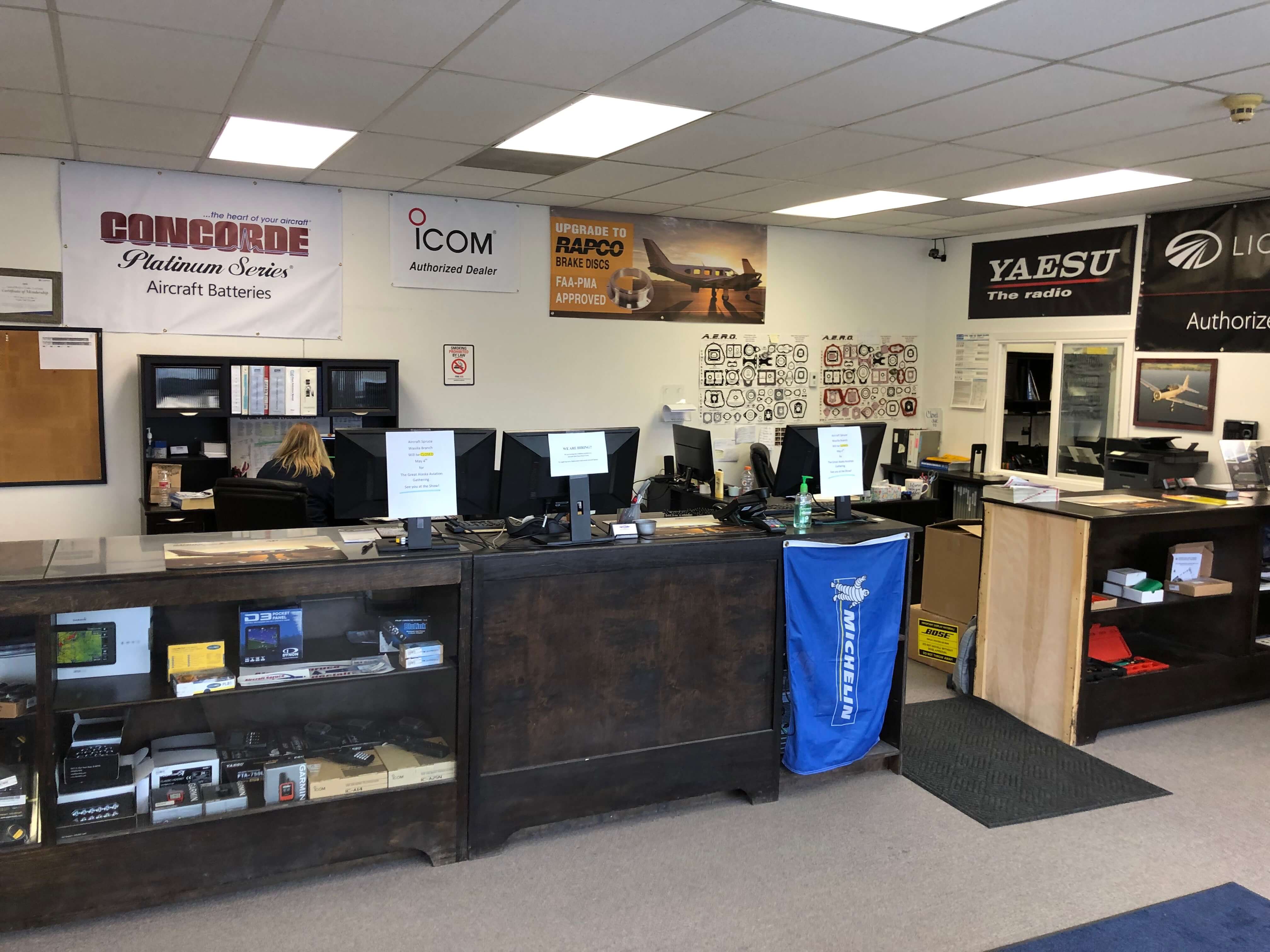Aircraft Sprice - With the advent of World War II, spruce became even more popular. Manufacturers used the material in the construction of a large number of aircraft. Wooden spars were fabricated from spruce in many airplanes along with ribs and other structural parts. Because of the high demand for both aircraft production and for spruce to be used as a major material in manufacturing parts, forests of this popular wood were rapidly depleted. The use of Sitka Spruce was carried into post-war construction in many aircraft. The maintenance and restoration process of existing aircraft required a large supply of wood. Wood was a popular choice for aircraft construction because of its advantageous strength to weight ratio, workability, abundance, and low cost. The largest plane ever constructed - the Spruce Goose - is largely comprised of spruce. During this time in aviation history spruce was cheaper than aluminum or steel.
With six engines, the Scaled Composites Model 351 Stratolaunch is a double fuselage unit and has the largest wingspan of any aircraft in history, measuring 117 m (384 ft). Like the Spruce Goose, the program has also been met with several challenges. More recently, a test flight was abandoned after unexpected results.
Aircraft Sprice
The aircraft would hold the wingspan record until the recent history when the double-Boeing 747 fuselage Stratolaunch took to the skies - channeling the inner spirit of the Spruce Goose. Moreover, When it comes to everyday aviation, the An-225 ruled when it came to size until it was destroyed this year following the invasion of Ukraine.
Why Did It Only Fly Once?
The use of Sitka spruce is certainly not limited to aircraft construction. As a matter of fact, the aircraft industry uses a very small percentage of the total spruce that is milled. The majority of spruce harvested is used for ladders, house construction, masts of sailboats, barrels, cabinets, sounding boards for organs and pianos, and other uses. The building and restoration of sport aircraft is a very insignificant market for the wood industry. To further complicate the issue, several forests of spruce are protected from cutting by environmental issues such as preserving the spotted owl.

The sale of spruce is a nightmare for a supply company. The price they pay for shipments of spruce is very high. In addition, they have high costs in preparing the wood for shipment. The wood is very easily damaged when working with it or storing it. And finally, at least 40% of the wood they receive cannot be used for spar material. That means they must either cut the wood into smaller pieces to be sold as capstrips and longerons or burn them in their fireplace. Cutting the wood into smaller pieces is labor intensive. Even with the high price you will pay for a spruce spar the aircraft company is not making money. I was in that business for over 17 years and can personally attest to that fact.
Inspecting Wood For Aircraft Use If I cannot obtain spruce or any other wood that is certified for use on aircraft how do I know I have the correct quality? The answer is you don’t. You must find someone familiar with inspecting wood or learn more about it yourself. Now, there is certainly a difference between production aircraft and experimental aircraft concerning legalities. There is, however, no difference in concerns for high quality.
In the next issue I will outline the proper procedure for identifying and inspecting wood for use in aircraft. This will help you familiarize yourself enough with the major defects to be able to identify them and know that the wood you are using is safe. I will be quoting largely from Mil-Spec-6073, a document that can be purchased through Aircraft Spruce & Specialty. The Forest Products Laboratory also has a wealth of information concerning wood in general. They have been very helpful to the EAA and to custom builders in general. Aviation Information Services (infoserv@eaa.org) at EAA Headquarters also has a lot of good information regarding aircraft wood.

Why Was It Built?
Alas, the aircraft would take so long to design and build (thanks to Howard Hughes’ perfectionism) that Kaiser would abandon the project. Hughes would continue the project in his absence and rename it the H-4 Hercules. The military downscaled the project at the end of the war and reduced the program to a single prototype.
Western hemlock has been used in the construction of aircraft for a number of years. The popular Pietenpol airplane used Western hemlock in constructing spars for a number of years. The strength properties slightly exceed spruce and the wood may be used as a direct substitute for spruce. FAA Advisory Circular 43-13 notes that it is less uniform in texture than spruce.
Nonetheless, From the Spruce Goose to the 747 Stratolaunch, these juggernauts will always turn heads when spotted. The H-4 Hercules may not have seen much action, but it's an example of the pioneering nature that is embedded in the aviation industry.
Toll Free: 877-477-7823 Customer Service: 800-861-3192 Fax: 800-329-3020
Worlds Largest Wingspan
"The Hercules was a monumental undertaking. It is the largest aircraft ever built. It is over five stories tall with a wingspan longer than a football field. That's more than a city block. Now, I put the sweat of my life into this thing. I have my reputation all rolled up in it, and I have stated several times that if it's a failure, I'll probably leave this country and never come back. And I mean it." - Howard Hughes speaking to the Senate War Investigating Committee in 1947.
In this and subsequent articles, I will discuss the types of wood that can be used in aircraft construction, how to inspect the wood properly to ensure it is safe to use, tools needed for woodworking, plywood and glues, basics of aircraft woodworking, and how to inspect wood in a completed aircraft.

Alternatives to Spruce If Sitka spruce is so difficult to obtain why not find alternatives? A valid question and certainly a number of alternatives to spruce do exist. First of all, let’s look at what type of wood can be used to replace spruce within an aircraft structure. Understand that written information regarding the use of wood in aircraft is limited. The primary source of information for the builder may be obtained from FAA Advisory Circular 43-13, Government Bulletin ANC-19, and from a copy of Mil-Spec-6073. Advisory Circular 43-13 lists a number of different types of wood that may be used in an aircraft structure. Some of these are Douglas Fir, Noble Fir, Western Hemlock, White Pine, White Cedar, and Yellow Poplar. I will discuss the ones that are the most readily available - Douglas Fir, White Pine, and Western Hemlock.
Construction finished at the cost of $23 million ($306 million today) in 1947 (World War Two ended in 1945). On November 2nd, 1947, the plane underwent water taxi tests and, on the final test, took off for a brief 26 seconds for a mile (1.6 km) at an altitude of 70 feet (21 meters).
In 1942, the US Navy was losing ships to German U-boats in the Atlantic Ocean and needed a way to transport troops and supplies to Europe by air. Shipbuilder Henry J. Kaiser came up with the idea to work with the famous plane designer Howard Hughes to create the largest aircraft ever built.

Next week will mark 75 years since the Spruce Goose flew for the first and last time. During this period, the Spruce Goose plane had the biggest wingspan in the world, at 320 ft 11 in (97.82 m). It was a flying boat that had eight engines and weighed 400,000 lbs (181,436 kg). It would be able to carry more cargo than anything else ever conceived.
The dubbed HK-1 would be able to carry up to 150,000 pounds (68,000 kg) of materials, 750 troops, or two 30-ton M4 tanks. Different concepts were considered, including a double fuselage with up to eight engines. The plane would need to be built from wood and fabric rather than aluminum, as wartime rationing prevented the use of precious metals. Mind you, this wasn't any normal wood but a particular composite of plywood and resin made from Birchwood.
aircraft spruce company, aircraft spruce & specialty company locations, aircraft spruce corona, aircraft spruce & specialty co georgia, aircraft spruce coupon, aopa aircraft spruce promo code, aircraft spruce and specialty contacts, google aircraft spruce and specialty co
